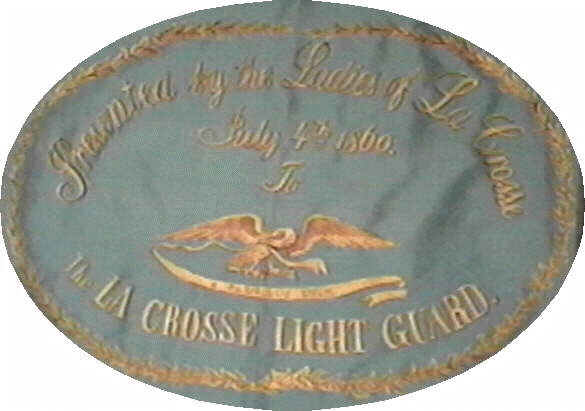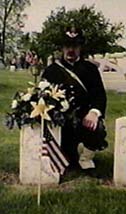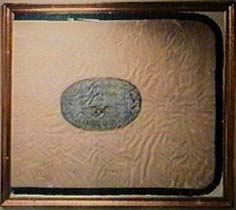Meet Company B
La Crosse Weekly Democrat
"Town and Country," Tuesday January 13th, 1863
"Found -- the late remains of Col. E. O'Connor of the 2d Wisconsin
Regiment have been found and buried in the Congressional Cemetery at Washington.
Col. O'Connor was an able and distinguished officer." (Note: This
notice published some four months following the fight at Brawner Farm, August
28th, 1862. Col. O'Connor's remains were later removed to Arlington National
Cemetery.)
Fred Beseler, La Crosse
Co. B
La Crosse Weekly Democrat
"Local and Other Intelligence" Friday March 27, 1863
"Proud -- We feel proud of Co. B 2d Wisconsin Volunteers, The La Crosse
Light Guard --and we have reason so to feel -- It is the oldest Company in the
U.S. service. We state this as a fact and can substantiate it. It has been in as
many battles, if not more battles than any other Company, and has yet never
shown the white feather. We believe it never will. First on hand in time of
danger and the last to leave the field of battle except under orders. Capt.
Hughes has reason to have great pride in his Company, and the friends of
"the boys" will also be pleased to know of their proud position."
Fred Beseler, La Crosse, Co. B
La Crosse Light Guard
Replica Flag
Nearly Complete
John Dudkiewicz, Company B, reports that the replica La Crosse Light Guard flag is very
near completion. At last report he only had a few more stitches to complete on the State
Seal side of the flag. He says that he may have it finished in time for Company B's first
"Echoes of The La Crosse Light Guards" lecture on March 16. Many thanks to John
for his work and also to Troy Buddenhagen for his terrific painting work. This is a
replica of the historic Light Guard flag that was presented to the men on July 4th, 1860.
This flag made the trip out East to the war and although it was not carried into battle,
it was nearly lost on several occasions. Eventually, it resurfaced in La Crosse and for
many years resided in a frame in the basement of the American Legion Post in
La Crosse. Company B raised significant funds for conservation and preservation of the
original flag which may now be seen at the La Crosse County Historical Society's Swarthout
Museum, 9th and Main Streets, in La Crosse.
Company B looks forward to marching under their beautiful replica Light Guards
flag this Memorial Day.
Worth The Trip
![[New!]](smallnew.gif)
By Frederick Beseler, Company B
Saturday, January 23, was a sloppy, rainy, snowy , slushy day, but nevertheless several
Company B members braved the slippery roads to visit the Wisconsin National Guard Museum at
Camp Douglas and the Wisconsin Veterans Museum in Madison.
The Wisconsin National Guard Museum at Camp Douglas is a wonderful, living museum is full
of life as it traces the history of the Wisconsin National Guard. In addition to covering
the civil war and Spanish- American war, much of the museum is devoted to the history of
the 32nd Infantry Division, which saw service in World Wars One and Two, as well as the
Wisconsin Air National guard. Korea, Viet Nam and the Gulf War are also covered. The
reason the displays come alive is because Camp Douglas and nearby Fort McCoy is where
these troops were trained. According to the curator, many veterans of the 32nd Division
have sent their artifacts and occasionally stop in to help create new displays. There are
also displays concerning the Wisconsin Air National Guard and its operations and aircraft
over the years.
The museum is open, free of charge, to the public and is located just off of Interstate
90-94 at Camp Douglas. Next time you're traveling the Interstate, take time to stop in.
You won't be disappointed. Don't forget to poke a couple dollars into the donation box
when you leave.
Later in the day Bill Brewster, Curator of Collections at The Wisconsin Veterans Museum,
met with us to show us some of the collections in the basement storage areas. Bill first
told us a little about the Museum and how and why items are collected. The main mission is
to tell the story of Wisconsin soldiers and their participation in United States armed
forces. As such, the museum seeks to collect items that belonged to Wisconsin soldiers or
belonged to veterans who later moved to Wisconsin. The museum now lists more than 20,000
artifacts in its collections.
We saw a variety of generic civil clothing items. Bill's explanation of each item
demonstrated his incredible knowledge of civil war culture and why he is the curator at
the Wisconsin Veterans Museum. Of course, we were there to see civil war items,
particularly 2nd Wisconsin items. We saw an original black ostrich plume and its little
crocheted socket that the plume was fixed into. Then, Bill showed us an interesting
collection of civil war handkerchiefs. According to the U.S. Sanitary Commissions
recommendations, these handkerchiefs measured 24 by 24 inches - much larger than the
"hankies" we carry today. They were also made of silk. We saw a black
(appropriate) silk handkerchief, picked up on Maryes Heights at Fredericksburg. There was
a linen handkerchief - obviously a table napkin pressed into service by a soldier. The
last handkerchief was the piece d' resistance - Col. Lucius Fairchild's scarlet silk
handkerchief that he had in his pocket at Gettysburg, July 1, 1863. As 2nd Wisconsin
reenactors know, Col. Fairchild was wounded in the arm, resulting in amputation of the
shattered limb. The handkerchief is stained with his blood.
We saw several tin items and two virtually identical sheet iron frying pans - one hand
made and the other commercially produced. They were not "cold handle" pans.
Another highlight was the shelter half that had belonged to a soldier of a Massachusetts
regiment who moved to Wisconsin after the war. This soldier had had the foresight to mark
the tent, "Tent I slept under before Petersburg, Va., winter of 1864-1865."
Next we saw Lucius Fairchild's kepi that he wore that day at Gettysburg. And a hat worn by
his brother Cassius, of the 16th Wisconsin.
All too soon our time had expired, but in that two and a half hours we had been thrilled
to see several important 2nd Wisconsin artifacts. Bill was kind enough to invite us back
to the museum later this year so that we can see an original 2nd Wisconsin black hat and
the Tiffany flag that are now undergoing conservation efforts. The items will be completed
and returned to
the Museum by mid-summer.
Good Ground
![[New!]](smallnew.gif)
By Frederick Beseler, Company B
Company B, Second Wisconsin Civil War Reenactors voted in January to donate $25 to the
Central Maryland Heritage Battlefield League (CMHL). This organization is heavily involved
in preserving the South Mountain battlefield site, including Turner's
Gap area where the Iron Brigade earned its nickname. This is also where Company
B Captain Wilson Colwell perished.
Our donation will "purchase" a square foot of land at the Iron Brigade site. As
soon as our certificate it will be printed in the newsletter so that all members have a
copy.
CMHL Executive Director Bill Wilson expressed great appreciation for the donation and is
very interested in the fact that a reenactment group from the home town of one of the Iron
Brigade regiments/ companies exists today. He invites our members to visit CMHL's offices
and museum in Middleton, MD. He also noted that there is an effort afoot in the Maryland
legislature to
make the South Mountain area a Maryland State Park, which will do much to preserve this
site for many years. Here is more info on CMHL's efforts as taken from their website.
Background
In September 1862, Gen. Robert E. Lee's Confederate army invaded Maryland to carry the
Civil War into the North. Lee then separated his army into five columns as part of a plan
to take the Federal garrison at Harpers Ferry, West Virginia. Union Maj. Gen. George
McClellan, moving his army from Washington, DC, to intercept Lee's forces, learned of the
Confederate plan
in Frederick, Maryland. Hoping to destroy Lee's divided army, McClellan ordered two Union
army corps to force their way through three passes in South Mountain: Fox's, Turner's, and
Crampton's Gaps. Maj. Gen. D. H. Hill's division and the Confederate cavalry defended the
passes. After a hard fight on September 14, the Federals gained the gaps, but the battle
for South Mountain provided the Confederates with time enough to force the surrender of
the 11,000 Union troops at Harpers Ferry. Lee withdrew from South Mountain and regrouped
his army behind Antietam Creek, setting the stage for the Battle of Antietam on September
17.
Preservation
![[New!]](smallnew.gif)
Preservation of this site began in the early 20th century when the National Park Service
(NPS) and the State of Maryland established parks (part of the Appalachian National Scenic
Trail along the mountain's crest and Gathland State Park in Crampton's Gap, respectively)
in the area. Local preservation activity began in the 1980s when Frederick County
purchased agricultural easements on battlefield land at the base of the mountain. During
this time, the Maryland Environmental Trust also acquired conservation easements in the
area.
In 1989, local residents established the Central Maryland Heritage League, Inc., (CMHL) to
preserve rural landscapes and historic sites in Washington and Frederick counties. The
CMHL has raised more than $100,000 to protect the South Mountain battlefield by
"selling" symbolic, square-foot parcels of the site. Maryland's Program Open
Space (POS), a state agency that funds the protection of agricultural land, has worked
with CMHL to develop a battlefield land acquisition plan. Since 1990, CMHL has acquired
more than 62 acres, including 22 acres paid for in part by The Civil War Trust and 25
acres bought with Civil War commemorative coin revenue. In 1992, POS secured a total of
$4.2 million, the combination of an ISTEA grant and a required match, to protect
battlefield land at South Mountain. POS has helped protect more than 430 acres to date.
Today the CMHL, the State of Maryland, and the NPS protect more than 913 acres of the
battlefield. An additional .92 acres was added in May 1996 as a result of a $26,000
donation to the NPS by the National Park Trust. Frederick County is currently negotiating
with several property owners to acquire additional easements and the Maryland Historic
Trust is using funds provided by the ABPP to survey historic resources associated with the
battlefield.
To learn more about preservation activity at this site, contact Judy Ashley,
Central Maryland Heritage League, Inc., P.O. Box 721, Middletown, MD 21769, (301)
371-7090, or Grant deHart, Program Open Space, Tawes State Office Building, Annapolis, MD
21401, (410) 974-3581.
Hot Work
![[New!]](smallnew.gif)
By Frederick Beseler, Company B
Grasshoppers sing in the late August afternoon heat. Temperature and humidity reach
90-plus. The barrel of your musket radiates blazing heat while grime, road dust and powder
residue rolls off your face in beads of black sweat. Rebel artillery screams overhead as a
sergeant barks orders for another double-quick march to form a battle line in the middle
of Mr.
Brawner's hot, sun-baked cow pasture. Ahead, the gray Stonewall Brigade comes onward,
wavering in the shimmering heat waves like a mirage that is only all too real. This will
be "hot work" in more ways than one. Your legs wobble. Is it fear or thirst? The
last gulp of water from the canteen does little to quench either. Oh, for a soak in the
cool safety of the shady
mill pond back home.
In addition to the love of reenacting civil war battles, one reason we may tolerate a hot,
sweaty weekend in a wool uniform is that we know that at the end of the event, we can get
into an air-conditioned automobile to head for our air-conditioned home. In fact, the boys
of 1861-65 came very close to enjoying the benefits of air conditioning.
In 1839 37-year-old Dr. John Gorrie, a graduate of the College of Physicians and Surgeons
of the Western District of New York, arrived at Apalachicola, Florida. The prime killers
in this region of America were malaria and yellow fever. In researching the problem,
Gorrie concluded that he could save the lives of malaria patients if only he could reduce
the room
temperature in his hospital. By 1842, Gorrie devised an air conditioning system to treat
fever-stricken patients by blowing air over buckets of imported ice into the sickrooms.
But this was an expensive proposition as ice harvested and shipped from Boston cost as
much as 10 cents per pound.
In 1844 Gorrie wrote, "The houses of warm countries (should) be built with equal
regard to insulation, and a like labor and expense be incurred in moderating the
temperature and lessening the moisture of the internal atmosphere to reduce the threat of
malaria." He theorized that elevated temperature and humidity "prevents a large
portion of the human family from sharing the natural advantages they possess and causes
mental and physical deterioration to the native inhabitants."
In another article, "Prevention of Malarial Disease" Dr. Gorrie wrote,
"The proposed engine for ventilation and cooling air in tropical climates by
mechanical power is simple in its construction, requires but a small expense of power,
admits of being complete in its operation and its parts if well made are not liable to be
injured by wear. It consists of two double-acting
force pumps - one for condensing and the other for rarifying air - and an air magazine or
receptacle for condensed air. It may be placed in any part of a ship or house."
Gorrie correctly predicted a future when "fruits, vegetables and meats would be
preserved in transit and thereby enjoyed by all." Within three years Gorrie had
constructed a working system in Cincinnati, which he then disassembled and shipped to New
Orleans. Dr. Gorrie then petitioned for his patent. Although his patent, No. 8080, for
"the first machine ever to be
used for mechanical refrigeration and air conditioning" was confirmed in 1851,
Northern newspapers aligned with the ice cutting and shipping trade ridiculed Dr. Gorrie
and attacked his idea so vehemently that Gorrie could attract no investors to fund putting
his miraculous machine into production. He received not a single penny for his invention
and died in 1855 at mid-life, discouraged and broke. Nevertheless, his machine provided
ice and air cooling for history's first air-conditioned hospital ward.
Air-conditioning was a real possibility during the civil war and we wonder at how many
lives might have been saved if Dr. Gorrie's invention received financial backing. Today,
we can thank Dr. Gorrie for refreshing, cool air on hot of summer days - when only mad
dogs, Englishmen - and reenactors-- venture forth to do battle. Information for this
article is from "John Gorrie, The Visionary," by John Gladstone in ASHRAE
Journal, magazine of the American Society of Heating, Refrigerating and Air Conditioning
Engineers, December 1998.
Andersonville Revisited
![[New!]](smallnew.gif)
By Frederick Beseler, Company B
For a couple of years since getting into this hobby, I had been led to believe that no
records of the surviving prisoners of Andersonville had been kept and that only the
records of the dead had been cataloged by Clara Barton. Thanks to a lead from a fellow
cybernaut, I have found a searchable database website of 32,000 prisoners of
Andersonville. As a result, I believe that I am very close to identifying my great-great
grandfather who had apparently been a prisoner there.
For those with computers, here is the website address:
<http://oglethorpe.corinthian.net/mccc/plookup.htm>
All you need enter is first name and last name. After the "wheels and gears"
grind a while you will get a list of prisoners with those names. You do not have to enter
a first name, although it will help narrow your search,. Here is a sample output, in this
case for Charles Bushee of Company B, 2nd Wisconsin Infantry.
Code No.: 18641
Grave No.: 8641
Last Name: BUSHEE
First Name: CHARLES C.
Rank: CORPORAL
Company: B
Regiment: 2
State: WI
Branch of Service: INFANTRY
Date of Death: SEP. 13, 1864
Cause of Death: DYSENTERY
Remarks: C. C. BUSHEE, 09/12/1864 [1]; C. C. BUSHELL [3]
Reference: p 68 [3]; p 351 [414]
Place Captured: WILDERNESS, VA
Date Captured: 5/5/1864
Alternate Names: BUSHELL
More Information Available: NO

This is a replica of the La Crosse Light
Guard Flag Oval painted by Troy Buddenhagen. Company B dedicated a replica of the Light
Guard Flag to American Legion Post #52 in February of 1997, in recognition of the Legion
putting the original flag on permanent display at the La Crosse Swarthout Museum.
We also take on occasional projects, such as
raising $5,500 for preserving the 1860 La Crosse Light Guard Militia Flag in 1995. This
flag hangs proudly in the La Crosse Swarthout museum today.
We are also held a raffle to raise $350 to help
preserve the Iron Brigade Flag in the Wisconsin Civil War Museum in Madison.
We have also donated money to various veteran
memorials, such as buying a brick (commemorating the Original Company B) in the West
Salem, Wisc. Veteran’s Memorial.
Gary
Lanke (Co. B.) pays tribute to
Charles Gordon Wilds of the
17th Iowa Volunteers at La Crosse Oak Grove Cemetery.
Wilds was the Great Great Grandfather
of Gary's wife, Jan Lanke. |
 |
 |
This is the original flag of the
La Crosse Light Guard, donated to them on July 4, 1860 by the ladies of La Crosse. The
Light Guard became Company B of the 2nd Wisconsin at President Lincoln's first call for
volunteers in April of 1861. This flag was preserved by the modern Company B in 1995, and
hangs in the LaCrosse Swarthout museum today. |
Many
members do community and school presentations and living histories.


